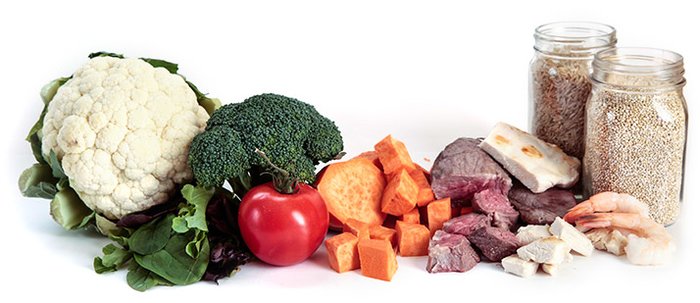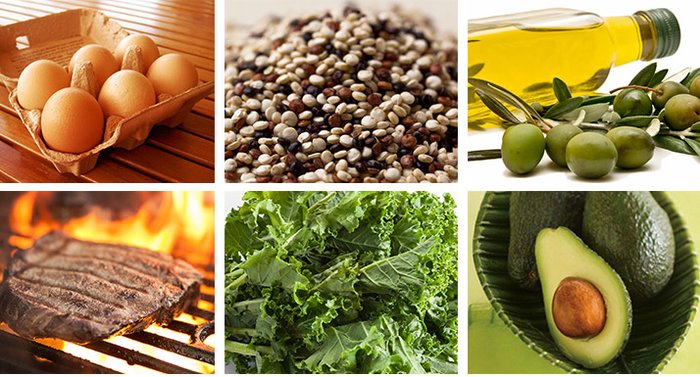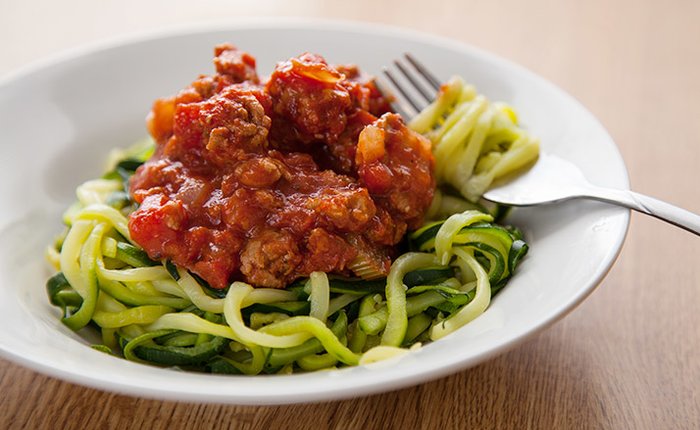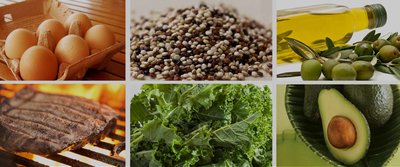If you took a quick poll and asked any Joe or Jane off the street about the best way to lose weight, their answers would likely be the same: "Eat less food."
As a society, we've been surrounded by the message that, in order to drop unwanted pounds, we have to drastically reduce our daily calorie intake. But what if I told you this notion couldn't be further from the truth? What if, in order to lose weight, you actually need to eat more food?
This may sound radical, I know, but it's true—especially if you have a plan that's easy to implement and just as easy to stick with. To build your own such plan, read these eight tips to learn how you can eat more, lose weight, and enjoy your diet!
1. Pump up the Volume
OK, this may go without saying, but your stomach is not a calorie counter. High-calorie foods without a lot of volume—oils and ice cream, for example—won't do much to fill you up, even though they're extremely energy-dense. You'll get full with a high volume of food, so that's what's important here!
Now, when I say "food volume," I don't necessarily mean massive amounts of indiscriminate calories. When it comes to weight loss, you have to think in terms of quality as well as quantity. Eating more to lose more is all about eating the right kinds of foods first, and then eating a lot of them.

Eating more to lose more is all about eating the right kinds of foods first, and then eating a lot of them.
This isn't as hard as some people make it out to be. Intuitively, you know whether a food is something you should be eating or not, but instead of labeling foods as "good" or "bad," think of them in terms of what they can do for your body and how they can help you achieve your goals.
Take a doughnut for example. Can you fit a doughnut into your diet and still lose weight? Of course you can, but it wouldn't be a very sensible choice, since it's devoid of nutrients, not particularly satisfying, and happens to be a calorie bomb. After you eat it you'll get a brief burst of energy from the sugar, but then you'll crash shortly after. Then you'll crave more sugar. That's not a fun cycle.
You'll feel better and much fuller if you find nutrient-dense foods you can eat a lot of. Oh, and those foods—like greens, lean proteins, and complex carbs—will actually contribute to your goals.
2. Don't Go Cut Crazy
Cutting a ton of calories or eliminating food groups is also not a great strategy, yet many people still believe that's the best way to lose weight. Do you know why? Because at the end of the day, it works! You cut carbs, and guess what happens? You become more conscious of the foods you're consuming. Then you eat less food, thereby causing a huge daily calorie deficit and some solid initial weight loss. Great, right? Well not really. At this point, you're building an unhealthy relationship with food.
You're not learning balance and portion control, and once your body begins to figure out what's happening and stops responding, you won't be able to maintain that initial weight loss. Eventually, you'll binge, fall off the wagon, and be back at square one.
This is not to say that counting calories is bad— I actually count calories myself. Anything that can make you mindful of what you're putting into your body is not a bad thing. But calorie counting alone is not going to get you results. In order to achieve your weight- and fat-loss goals, you need to count your macros as well.
3. Master Your Macros
When people talk about macros, they're referring to macronutrients: protein, carbs, and fats. Simply counting the number of calories you eat won't tell you if you're getting enough of each food group; it won't tell you if you got enough protein to add muscle or enough carbs or fats to stay satisfied.
Macro counting, however, will enable you to break those calories down into the specific foods and food groups that are required to meet your goals. Calculating macros takes all of the guesswork out of dieting and provides you with a style of eating that will get you results for years to come.

Calculating macros takes all of the guesswork out of dieting and provides you with a style of eating that will get you results for years to come.
Since everyone is so different, it's difficult to deal in absolutes when recommending macros. In order to figure out your macros, first use a total daily energy expenditure (TDEE) calculator to determine your current caloric needs, or multiply your body weight in pounds by 15 for an easy estimate.
From there, you can figure out how much of each macronutrient should make up your diet. I recommend 1.2 grams of protein per pound of body weight and 0.5-0.7 grams of fat per pound of body weight. The rest of your calories should come from carbohydrates.
If you learn to think in terms of macros, everything else will fall into place. Determine what your goals are and what balance of macros you need to achieve them. Then, parcel those macros into three meals and 2-3 snacks daily. It sounds like a lot of work, but truthfully it's no more work than counting calories.
For example, instead of just adding up the number of calories you're eating in a meal, add the grams of protein, carbs, and fats separately to ensure you're hitting your macro targets.
4. Get Smart About Swaps
You might find that once you break up your meals into smaller portions, you don't have a lot of food on your plate. Now we're back to the topic of volume. Swapping certain foods for others is a great way to maintain food volume and reduce unnecessary, additional calories at the same time.
For example, look at this comparison:
- 1 cup of basmati rice = 192 calories, 40 grams of carbs
- 1 cup of cauliflower rice = 25 calories, 5.3 grams of carbs
I could whip you up a healthy curry with both of these "rices," and you wouldn't be able to taste that much of a difference. But the difference in calories is 167 per serving for the same volume of food. That amounts to an entire snack you can have later on without sacrificing food volume in your meal right now! It will still fill you up and be satisfying while hitting your macro targets and getting you results.
Here are a few more substitutions to add volume to your food without adding calories:
- Trade this: Pasta | For this: Spiralized zucchini or spaghetti squash
- Trade this: Mashed potatoes | For this: Mashed butternut squash or cauliflower and turnips
- Trade this: Mayonnaise | For this: Mashed avocado or hummus
- Trade this: Sour cream | For this: Greek yogurt
- Trade this: Bread | For this: Whole-wheat tortilla
- Trade this: Sugar | For this: Maple syrup or stevia
5. Now Consider Cardio
I hear this a lot: "I can eat that big hunk of cheesecake because I am doing cardio later." Now, I'm all for doing cardio to be able to eat more food. In fact, most mornings I get up and walk for an hour, which burns about 500 calories. This means I can eat more food, but I still have to eat the right food in order to get amazing results!
You can't out-train—or, in my case, out-walk—a bad diet. Cheesecake is not a wise food choice if you're dedicated to getting lean and dropping weight. At the end of the day, if you have a calorie surplus, you're going to gain body fat. But if you keep your surplus to a minimum, and make sure it comes from good, healthy foods, staying active with cardio can help you stay lean all year round.
6. Balance Your Life
All that being said, at the end of the day, you have to have a life. No one can be strict 100 percent of the time, and who wants to? Especially during the holidays and special occassions. It's a time to celebrate with family and friends, and that often comes with a high-calorie price tag. Don't stress—it's completely fine to have a cheat meal every now and then.
Ultimately, adopting an 80/20 principle—where you eat healthy 80 percent of the time and indulge 20 percent of the time—will reap similar long-term results and be a lot more sustainable than trying to stay "clean" 100 percent of the time. You won't feel the urge to binge on foods, because you're not completely deprived, and you'll stay happier and more sane as a result.
7. Make Your Diet Pop
Now that you know the basics of dieting smart—eating good foods in high quantities, finding the right foods, and figuring out your macros—it's time to bring it all together in the kitchen.
The biggest misconception people have about dieting is that it has to be boring, extreme, and overly restrictive. This could not be further from the truth. In fact, dieting can be healthy and tasty; you just have to discover the right healthy recipes!
While there are scores of healthy recipes on Bodybuilding.com, I wanted to share one of my all-time favorite meals to make. It's high in protein, low in starchy carbs, and packs on the volume. Plus it tastes great!
Turkey Bolognese Zucchini Pasta

8. Supplements
Once you have everything else about your diet in place—food quality, total calories and macros, recipes, and more—then it's time to frost the proverbial cake with some select supplements.

Supplements are a great way to boost your fat-loss potential and bolster particular macro numbers that are critical to building and maintaining muscle, like protein.
Supplements are a great way to boost your fat-loss potential and bolster particular macro numbers that are critical to building and maintaining muscle, like protein. Here are my top three supplement recommendations to facilitate any fat-loss diet:
Protein: A quality protein powder will help you easily keep your protein intake sufficient (without adding extra calories) so you can maintain muscle mass even when dropping body fat.
Multivitamin: A healthy body is a happy body, and you will achieve greater results when you focus on getting your micronutrients as well as your macronutrients. Throw a high-quality multivitamin in your bag, and you'll be ready to go!
Protein bar: Protein bars are great for beating cravings while losing weight. My favorite bar, the Grenade Carb Killa, is a delicious low-carb, high-protein snack bar you can eat between meals to get your daily chocolate fix!

